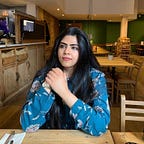Chelsea Physic Garden (Micro UX) — Week 1 | The Secret Life of Plants 🪴
(22 April — 29 April)
After we sprang out of the strenuous submission for the Macro UX unit, we got presented with a project brief involving partnership with another external organisation. This unit focussed our attention to the detail of UX project work, including interactions, technical implementations, integration and delivery organised around a range of broad themes.
The four companies introduced this time were: Bittersuite, Chelsea Physic Garden, Moley Robotics and This Ain’t Rock’n’Roll. I got assigned on an interesting brief pitched by the Chelsea Physic Garden to devise interactions between plants and humans.
Team : Erid Dodd, Maria Carolina Séves, Sanya Nayar and Vanessa Van
Initially we started as a group of eight but later on segregated into groups of four. This time also we exercised self-organisation into our desired teams, clearly without much fuss unlike the previous time.
Chelsea Physic Garden situated in London originally started as an establishment by the Apothecaries in 1673 to grow medicinal plants which presently houses an estimated collection of 5,000 varieties of plants from around the world. It enjoys a unique microclimate because of its south facing aspect and proximity to river Thames, helping to diffuses warm air currents.
Brief : To design a set of interactions between plants and people that takes places at a microclimate level by using digital technologies to amplify movement, magnify time and intensify relationships.
This supports their mission of developing intimate connection with plants by creating an embodied experience for the visitors. On the first day of launching this project, we had the opportunity to talk to Frances Sampayo who is the deputy director of the visitor experience at the Chelsea Physic Garden. The information that she contributed to the explanation of this brief can be encapsulated in two key points:
- Plants are also a measure of microclimate.
- The outside world mirrors the inside world, i.e, the changes taking place within the boundaries of the garden can be extrapolated to deduce the general shift in climatic pattern in the outside world.
We jumped into action a day after to discuss our initial thoughts. I was specifically interested by the magnification of time mentioned in the brief and drew an analogy of it with the theory of relativity.
“ When you are courting a nice girl, an hour seems like a second. When you sit on a red-hot cinder, a second seems like an hour. That’s relativity.” — Albert Einstein
A series of simple sketches showed how qualitative analysis could be arranged to collect data on chronoception which would represent the difference between the actual time spent and the time a person thinks had lapsed during a meaningful conversation with plants.
However, as it was too early to define a direction, we took a rest and planned a visitation to the garden on upcoming Monday. The other CPG group joined us as well on that day which helped in collection of a diverse range of information on the subject.
GARDEN VISITATION
We were enthralled to see a variety of exquisite species of plants from around the world being preserved in the garden. My favourite one was the Jacaranda tree which is native to tropical and sub-tropical regions of the Americas. To make a useful understanding of the visit, we documented our findings through the following methods:
RECORDING PHOTOS AND VIDEOS
COLLECTING SPECIMEN OF FALLEN FLOWERS AND LEAVES
I assimilated seeds and flowers into a herbarium to study their physiological structure in depth. More specifically, I was intrigued to see if the doctrine of signatures held any truth. While talking to Marion, we learnt about this code of analysis that had existed from the time of Dioscorides, been used to interpret signatures through the resemblance of a plant part to a human body organ it treats, the similarity of plant color to the color of symptoms, and by equating plant action to medicinal action. Even as she exclaimed that there were certain trees in the garden that obeyed this phenomenon, I couldn’t establish such a relationship in my findings.
INTERVIEWING STAFF AND VISITORS
Eric produced an AEIOU exploration that functioned as an easy mnemonic for guiding and coding observations made during our visit.
INFOSYNTHESIS
The next step after synthesising this information was to come up with relevant ways in which humans could benefit from interacting with plants. Conversely, it should have been the plants prehending the surroundings that needed to be brought to humans’ level of perception, as informed by John in the Tuesday tutorial. It then lighted on us that our target audience were the plants themselves.
For the final presentation, Maria also bought an Arduino set with sensors that could be used to detect light, proximity, temperature, etc to determine how plants responded to external stimuli.
We were reasonably successful in intriguing the audience with our intention of unraveling the secret life of plants as our project goal. Talking to Alaistair and John after the classroom presentation, we grew educated about the wood wide web that operates underneath the ground. That fascinated us as this phenomenon was fairly new to us and indeed more mystifying. Additionally, to inspire our thinking in subversion to human supremacy, they gave us an outstanding reference of the Marshmallow project being displayed at the Saatchi gallery which imparted an embodied learning to humans about plant-animal connection by using a combination of technologies from untethered virtual reality to heart rate monitor and body tracking.
We got cracking with doing research about the new-found concepts and after a day of rest, gathered together for a detailed discussion. What followed afterwards will be explained in the next blog.
